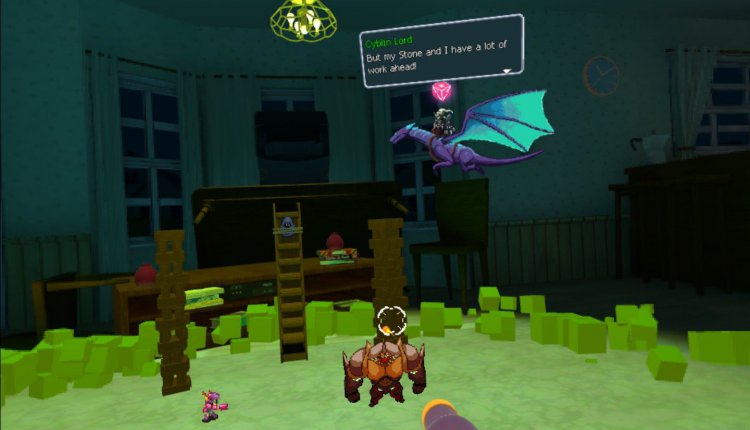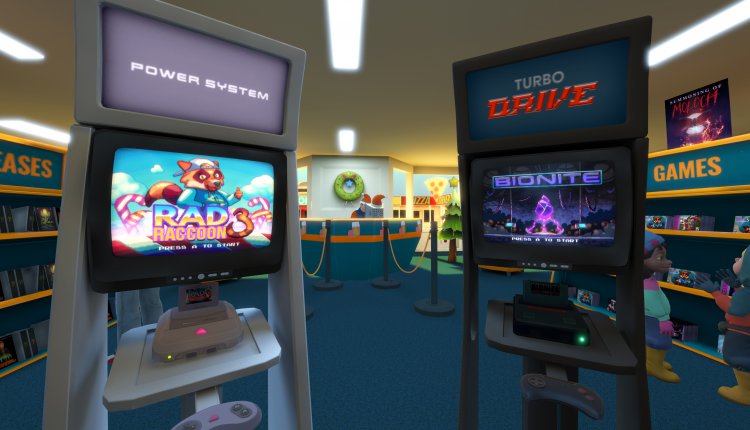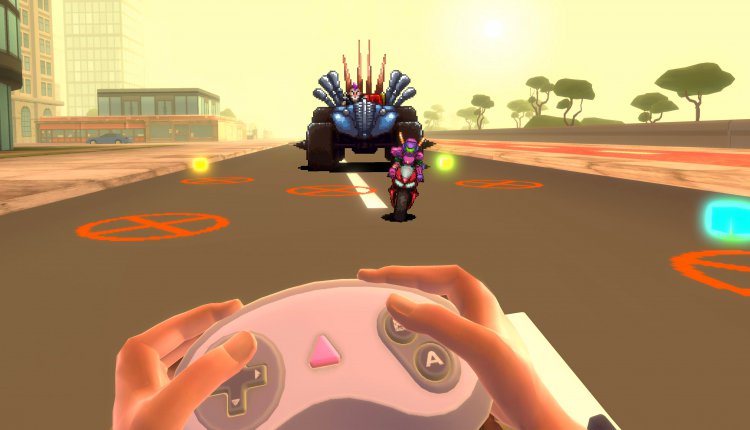Pixel Ripped 1995 — Headset Hero
Pixel Ripped 1995 sends you on a virtual trip back into the nineties, with a story that spans both the real and digital. You play as the hero Dot, and with the help of a human boy you’ve inhabited, named David, you bravely fight to save multiple dimensions from the evil Cyblin Lord.
This review comes with a disclaimer. No, Pixel Ripped 1995 is not a bad game, in fact, it’s very much to the contrary. It’s just that, if you’re a child of the eighties or nineties, nothing you are about to read can prepare you for what strapping on a headset to play this virtual reality game is like for the first time, or at all, really. Pixel Ripped 1995 is smart, it’s nostalgic as hell, and it may just give you the immersive virtual reality tingles that you’ve read of before but never have experienced.
Coming straight from the Game Boy styled worlds of Pixel Ripped 1989, this sequel drops you into a monochromatic room with a handheld device in your lap. Looking down at it in your virtual hands, you control a small version of Dot and lead her through the ‘story so far.’ This teaches you the controls and gives you some context in case you didn’t play the first game in the series — which is a rather clever mechanic that prepares you for what to expect in the rest of the adventure. The Cyblin Lord has a lot of power here and demonstrates it by blowing apart the room you’re in, and the walls, furniture, and random chicken fly off into oblivion. You awaken to the voice of your Master, who tells you about the Cyblin Lord’s ultimate plan: to completely take over the game world.
The struggle throughout the game is maintaining control of a Pixel Stone, a magical relic that maintains balance in the world of games. Naturally, the Cyblin Lord is trying to use it for his own nefarious gains, and you’re trying to keep it out of his hands. Your first game-within-a-game, Pixel Ripped: A Dot to the Future, is a top-down RPG-style game. Instead of a sword or blade of any kind, you use your blaster to fire at and destroy enemies and obstacles.
 It’s a very simple game, but it serves a purpose in its simplicity: your mom will stop at nothing to keep you from ‘burning your retinas out’ and will constantly be trying to turn off your system, that is, if you don’t distract her first. You have a foam dart blaster near your console that you must use to cause mischief in order to keep her from hitting the power button on your console. Breaking cookie jars and turning on the stereo with your darts are tasks you’ll have to do while juggling playing the game with both hands; it makes for some proper anxiety when the mom looms over you in a tense spot. If she does happen to get to the button before you turn her gaze elsewhere, you’ll start back at your last checkpoint, so at least you don’t have to start the entire game over, but it serves as a reminder of struggles back in the age of pagers and pop music.
It’s a very simple game, but it serves a purpose in its simplicity: your mom will stop at nothing to keep you from ‘burning your retinas out’ and will constantly be trying to turn off your system, that is, if you don’t distract her first. You have a foam dart blaster near your console that you must use to cause mischief in order to keep her from hitting the power button on your console. Breaking cookie jars and turning on the stereo with your darts are tasks you’ll have to do while juggling playing the game with both hands; it makes for some proper anxiety when the mom looms over you in a tense spot. If she does happen to get to the button before you turn her gaze elsewhere, you’ll start back at your last checkpoint, so at least you don’t have to start the entire game over, but it serves as a reminder of struggles back in the age of pagers and pop music.
Eventually, you make it to the first boss fight of the game, where the Cyblin Lord brings his minions into the real world to fight you, in your own living room, no less. This larger-than-life spectacle uses the same controls that you’re used to, but some real-world surprises add to the complexity of the encounter. This is a big part of what makes Pixel Ripped such a charming delivery of what being a kid is all about: the wonder and excitement of using your imagination. Even though the encounter is demonstrated as ‘video games coming to life’, it’s a spectacular transformation that showcases how much respect ARVORE has for the content that their games pay homage to.
Another reference that may ring true to your own childhood experiences is the annoying neighbor kid in the game. His uncle works for a gaming company, and he boasts throughout the game about secrets, new systems before they release, and how much better he is than you. He’s a take on that annoying kid that always knew it all, but secretly had security issues and had to fabricate a false narrative to make him seem cooler than he really was. Pixel Ripped 1995 paints this character with the traditional tropes, but they do a really good job of allowing you to peek behind the curtain and really understand the character instead of resorting to the typical ‘bullies are one-sided and bad’ stereotype.
The first game you play, A Dot to the Future, plays like Final Fantasy and Guardian Legend from the NES. In the video game store, there are two games you play, one mimicking Sonic the Hedgehog and the other Super Metroid, and you eventually end up switching back and forth between the two simultaneously to swap power-ups and progress past puzzles. It’s a smart mechanic — something I can say I’ve never seen before — and yet another clever twist on the gameplay formula that makes Pixel Ripped 1995 feel so special.
 Your living room, a video game store, your bedroom, the back of a station wagon, and an arcade all serve as the incredulous settings in which your game playing takes place, both digital and within the real world for each of the boss fights. Each game offered within the confines of a screen in the world of Pixel Ripped 1995 has a reference or sometimes multiple references to a video game from the era. There is some consistency throughout: the health you collect are rainbow dots or cubes, depending on the game, that spill everywhere when you are hit. Think of the health system of Sonic’s rings and you have the right idea. If you get hit again without collecting some before they disappear, it’s game over.
Your living room, a video game store, your bedroom, the back of a station wagon, and an arcade all serve as the incredulous settings in which your game playing takes place, both digital and within the real world for each of the boss fights. Each game offered within the confines of a screen in the world of Pixel Ripped 1995 has a reference or sometimes multiple references to a video game from the era. There is some consistency throughout: the health you collect are rainbow dots or cubes, depending on the game, that spill everywhere when you are hit. Think of the health system of Sonic’s rings and you have the right idea. If you get hit again without collecting some before they disappear, it’s game over.
Don’t worry if you haven’t seen your favorite game listed yet, Castlevania, Final Fight, and Donkey Kong Country inspired games make appearances later, too. Each of these games follow the idea of using simplistic gameplay with chip-tastic music that fits each one perfectly. I would love to see fully fleshed out game ideas that are direct ports of these childhood-defining games, but if they were any more involved, it would be challenging to both play and deal with angry moms and other distracting characters in the background.
As you progress through the game, you progress in time, and David ends up getting different consoles to play on. By the end of the game, he’s fully upgraded to the equivalent of the original Playstation and with it comes 3D graphics. References to Crash Bandicoot, Mario 64, Star Fox, and a horror game I couldn’t quite put my finger on make excellent source material for the games David plays. It’s nice to see how the developers took their own inspirations for game design and put them right back into their work. It’s not unlike the game itself in some ways, to be honest.
Pixel Ripped 1995 expands the game-within-a-game idea from the original even further, with a Wreck-it Ralph take between the real world and the digital, hopping and interacting between the two. ARVORE has created an exciting and unique experience that works hard to respect and honor its source material, and sweating from every pore is a nostalgic appreciation for the classics that inspired the games we play today. While this game wraps up in three to four hours, it’s one of those jaw-dropping experiences that sticks with you even after the credits roll. I have never had such an amazing time playing a game, let alone one that sends you back in time to the decade that helped define who I am today. I recommend that everyone give this game a shot, because you might just find that lost child repressed inside of you, waiting to be given another chance to be a hero.
Pixel Ripped 1995 is available now on Oculus Quest, Rift, and Steam. A Playstation VR version is scheduled to release soon, but no specific date was given.
Comments are closed.